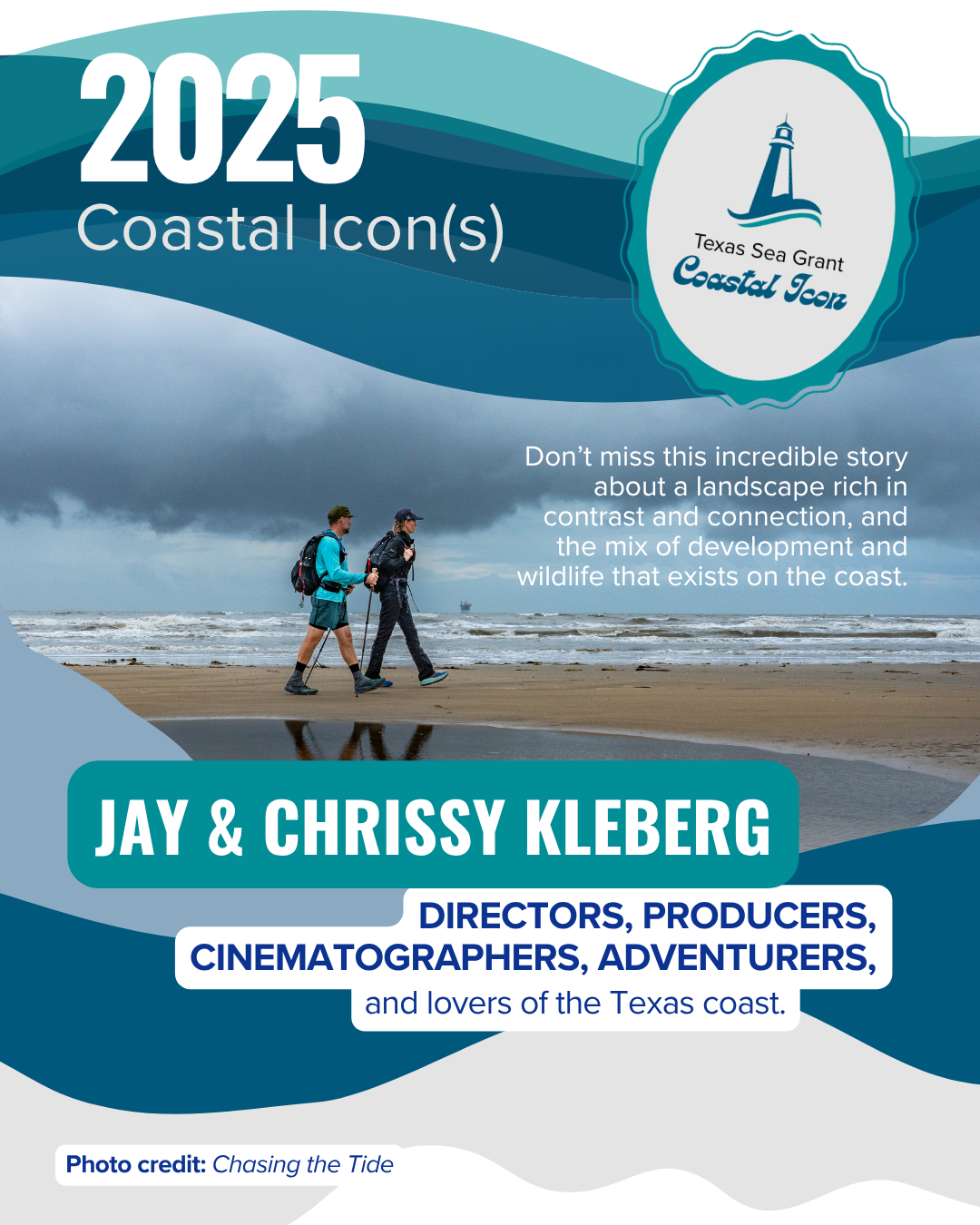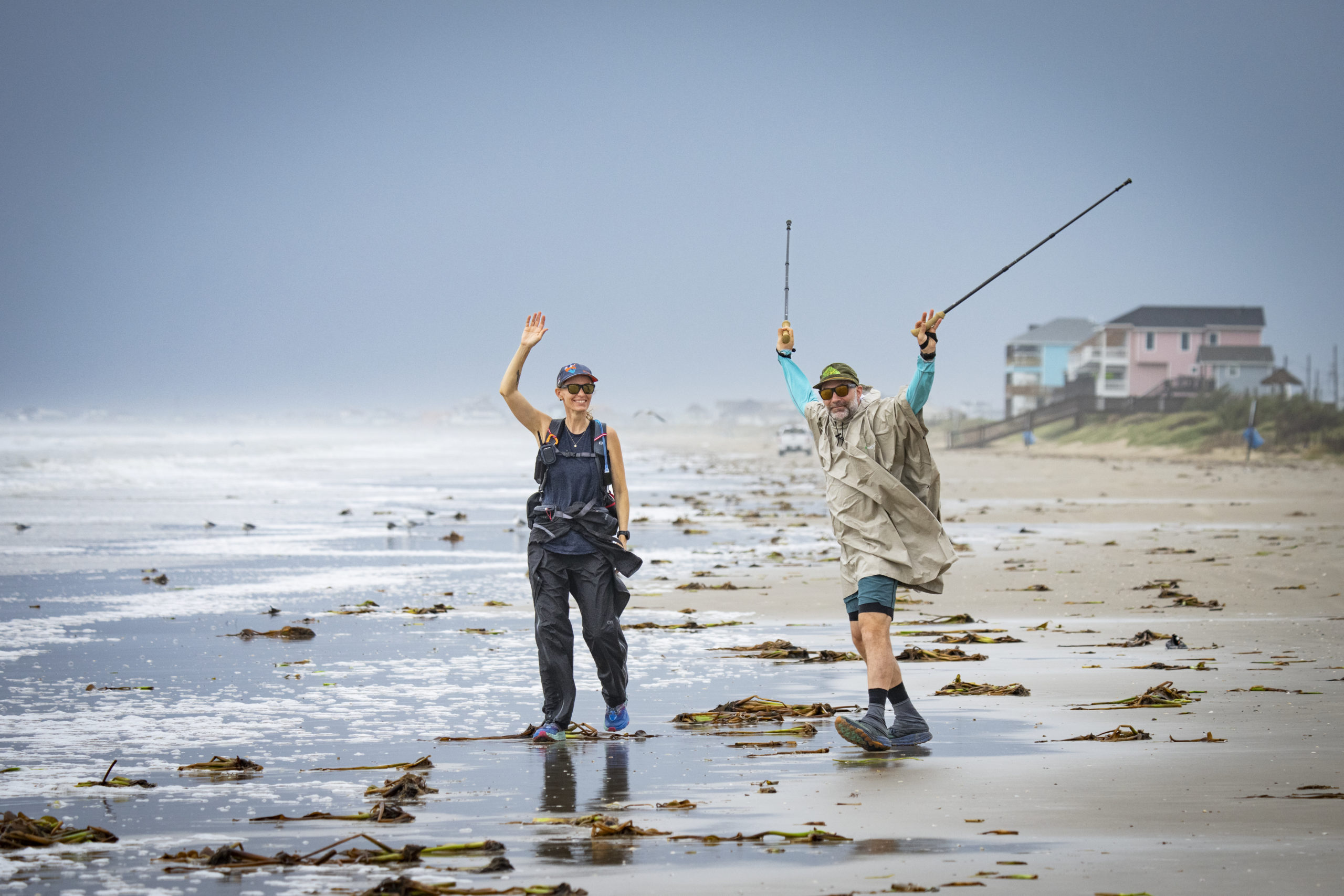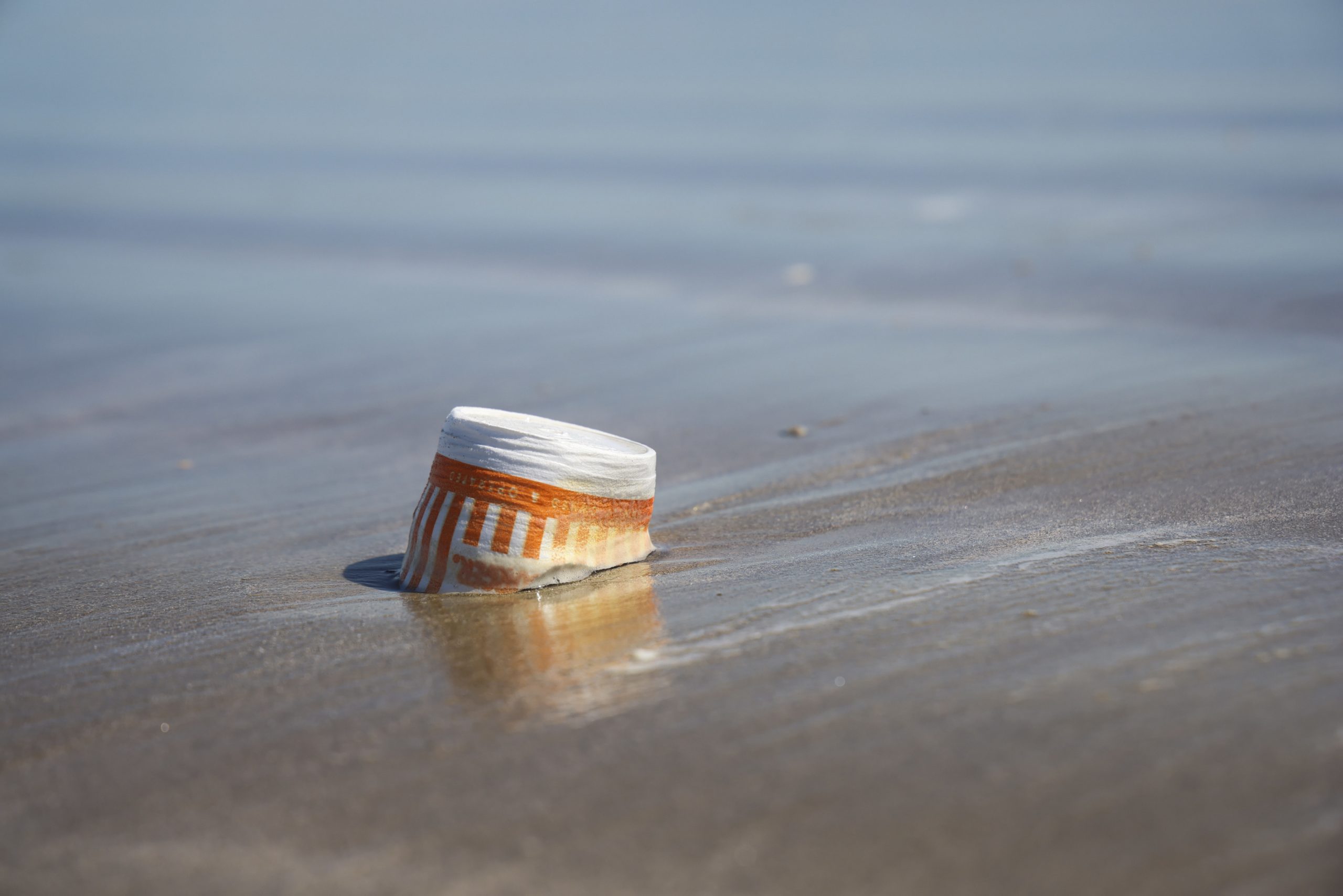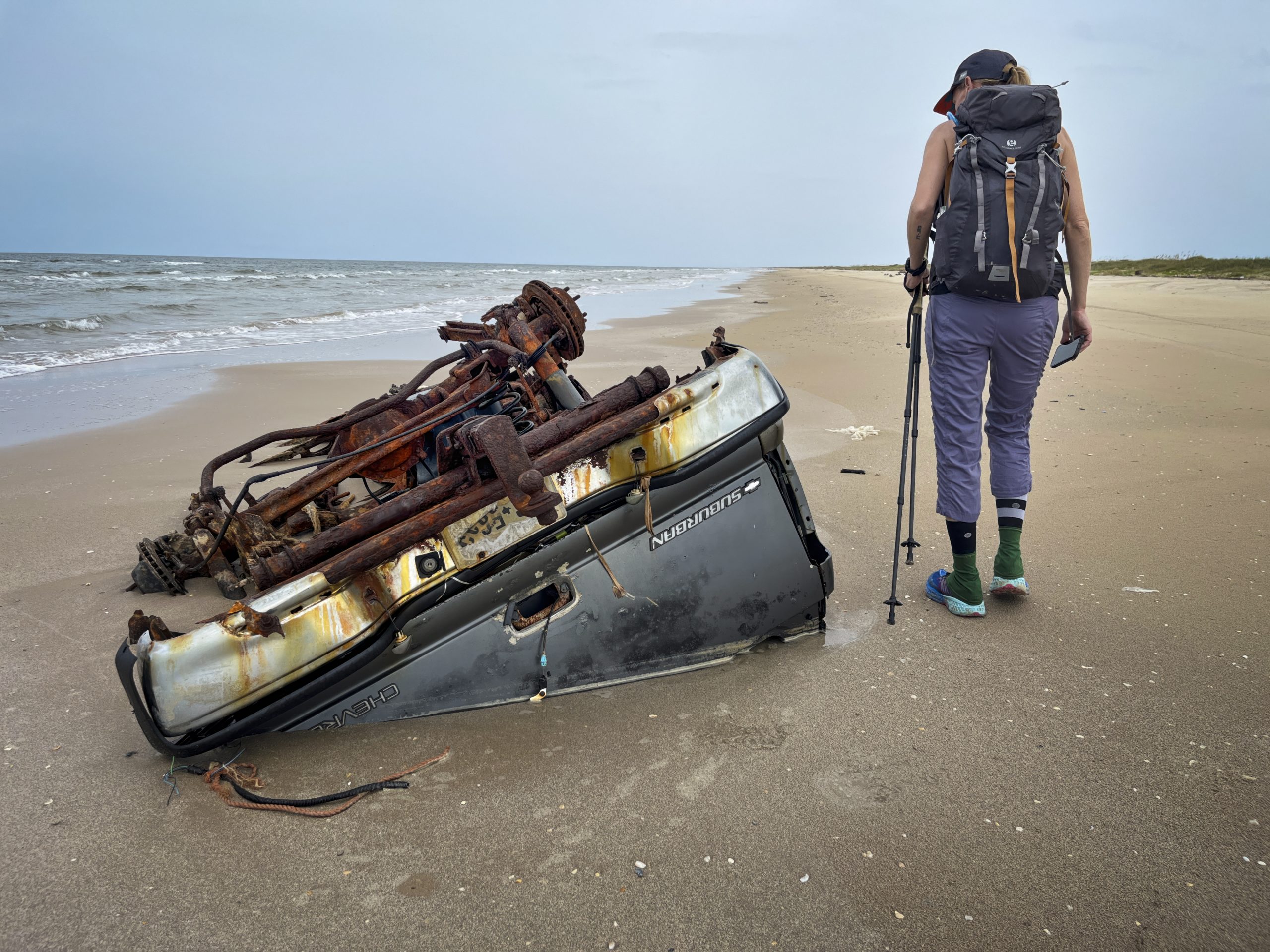Stewards of the Shore: How the Klebergs Champion a Wild and Resilient Texas Coast
Jay and Chrissy Kleberg walked 370 miles of Texas coast to reveal its beauty, resilience, and threats—like plastic pollution. Chasing the Tide is their tribute to a wild, working shoreline and a call to protect what sustains Texas’s people, wildlife, and future.
Jul 10, 2025 By Megan Towery Communications Director
12 minutes
 Jay and Chrissy Kleberg pushing through the rain on Galveston island; Awarded Texas Sea Grant’s 2025 Coastal Icon
Jay and Chrissy Kleberg pushing through the rain on Galveston island; Awarded Texas Sea Grant’s 2025 Coastal IconThe wind carries a tang of salt and damp earth as it sweeps across the salt marshes of the Chenier Plain, rustling the oak motts that rise like green islands from the flat horizon. A heron lifts off, its wings beating against the sky, and in the distance, a shrill cry echoes from a rookery island dotted with spoonbills and pelicans. This is where our story of Jay and Chrissy Kleberg, Texas Sea Grant’s 2025 Coastal Icons, begins.
Imagine standing along Texas’s ever-shifting coastline, where wildness endures in the whisper of sea grass, the hum of insects, and the roar of waves breaking on empty barrier islands. To stand here is to feel the pulse of something ancient and alive. Jay speaks of the coast as if it’s an old friend, shaped by history and resilience. From the engineered strength of Galveston’s seawall to the rhythmic surf near Surfside’s A-frame homes, from Matagorda’s silent lighthouse to South Padre’s vibrant ties to the Rio Grande Valley, this coast tells stories through its land, water, and people.
Home to a quarter of the state’s population and economy, the Texas coast is also its most biologically rich region. Its shifting salinity, ancient barrier islands, and the immense South Texas sand sheet create one of the most diverse coastal environments in the world. Here, upland and marine environments meet to support everything from blue crab to redfish, and from oysters to migratory waterfowl. In this ever-changing zone, 95 percent of commercially and recreationally important Gulf species begin their lives, and millions of migratory birds make critical stopovers each year, according to the U.S. Environmental Protection Agency.
The wind shifts as you travel farther south, where salt marsh fades into sand and the sky opens wide above a coastline in constant motion. It’s here, among rookery islands and hypersaline bays, that Jay and Chrissy Kleberg began a journey both physical and philosophical. In Chasing the Tide, their immersive coast-wide expedition and documentary project, they set out to walk the length of the Texas shoreline. What they found and hoped to share was a landscape rich in contrast and connection, where remote wilderness meets industrial infrastructure, and where ecosystems and modern economies interact every day.
The goal of Chasing the Tide is to help people recognize that the Texas coast is not just a geographic boundary but a powerful symbol and essential reality of who we are as a state. Both our history and our future are deeply connected to the health of our coastal environments and the Gulf.
Chasing the Tide is a meditation on the balance between conservation and development, between the ecological and the cultural, between what we’ve built and what remains wild. To walk it is to witness the natural systems that sustain not just wildlife, but a quarter of Texas’s people and prosperity. “While the Texas coast may have one of the longest coastlines in the country,” Chrissy says, “it’s the people and the smallest of things that make it so special. I’ve fallen in love with it and hope that the same will happen to those who see this series.”
For Jay and Chrissy, the coast is a mirror. Its shifting tides reflect where we’ve been and offer a glimpse of what lies ahead. Chasing the Tide is their way of showing that if we listen closely, the coast is speaking.

Pushing through the rain on Galveston island
Karine Aigner
Bearing Witness to Plastic Pollution Along the Coast
Throughout their 370-mile journey, Jay and Chrissy Kleberg came face-to-face with one of the most urgent threats to the Texas coast: plastic pollution. As they moved south along the shoreline, plastic appeared frequently, whether it was tangled in dune grasses, buried in sand, floating offshore, or wedged into the wrack line. According to a report from the National Oceanic and Atmospheric Administration (NOAA) and Ocean Conservancy, Texas has ten times more marine debris than any other Gulf state and the highest average weight of debris per mile surveyed. Much of this is funneled to the state’s coast by the Loop Current, a powerful oceanic current that brings trash from across the Gulf, the Caribbean, and even as far away as Africa and South America. On land, Texas’s proximity to major watersheds also means debris travels from across the U.S., Canada, and Mexico, ending with “nearly every one of Texas’ 30 million residents living in a watershed that empties into the Gulf of Mexico,” as noted by marine debris expert Jace Tunnell in Chasing the Tide. “This means that in addition to trash from other parts of North America and the globe, the Gulf receives all of Texas’ trash that ends up in a creek or river.”
To understand and document the scope of the problem, Jay and Chrissy conducted litter surveys every 25 miles. When the written data collection slowed their progress, they began recording voice memos to track their findings in real time. Over the course of the expedition, Chrissy and Jay encountered everything from sunglasses and swim goggles to boats and refrigerators. At one point, they happened upon a submerged SUV in the sand. They saw plastic fragments mistaken for food by shorebirds and discovered plastic bottles and containers scarred with diamond-shaped bite marks from sea turtles and triggerfish, drawn to what they believed were jellyfish or prey. “That plastic could be coming from anywhere, from a city in Texas, the middle of the U.S., from another country, travel down a river, out into the ocean, and then wash back up on the beach,” explained marine debris expert and director of community engagement at the Harte Research Institute at Texas A&M University-Corpus Christi, Jace Tunnell, who joined part of their expedition. It was a haunting reminder that plastic pollution is not only persistent, it’s planetary.
According to Tunnell, plastic never truly disappears; it simply breaks down into smaller and smaller pieces, which now endanger over 900 marine species, including whales, fish, oysters, and sea turtles. These fragments also make their way into the human food chain, where researchers are only beginning to understand their long-term impact on health. This awareness, born of boots-on-the-ground observation and backed by scientific research, is central to why Jay and Chrissy Kleberg were named Texas Sea Grant’s 2025 Coastal Icons during Plastic-Free July. Their expedition is not only a tribute to the wild beauty and resilience of the Texas coast, but also a call to action. They urge Texans to reduce their reliance on single-use plastics, carry reusable bottles (especially since 90 percent of U.S. tap water is safe), avoid plastic bags, and take part in cleanups or conservation programs. They go on to mention the Adopt-A-Beach program which mobilized nearly 12,000 volunteers to remove 154 tons of debris along 265 miles of shoreline, while Keep Texas Beautiful cleared 28 miles of waterways and collected more than 1 million pounds of trash and recyclables. The Klebergs acknowledge that Texans aren’t solely to blame for the trash washing ashore, but they believe Texans can and should be leaders in reimagining a cleaner, healthier future for the Gulf.

A polysterene Cup on the beach at Padre Island
Chasing the Tide
The Work Continues with a Trash Free Gulf
That leadership is something Jay has carried forward through his role as Executive Director of the Gulf Trust. Building on the awareness sparked by Chasing the Tide, he now helps spearhead the Trash Free Gulf campaign — a large-scale initiative aimed at shifting how Texans think about their relationship with the Gulf. Backed by H-E-B’s Our Texas, Our Future as presenting sponsor, and supported by Mender, YETI, and conservation partners like Keep Texas Beautiful and Texas Parks and Wildlife Foundation, the 2024 campaign mobilized over 2,000 volunteers in 45 coordinated cleanups. Taking place from late April through early June, these efforts removed 30,000 pounds of trash across every major Texas watershed, intercepting debris before it could reach the Gulf.
The effort brought together an impressive coalition of partners: Keep Texas Beautiful affiliates, H-E-B employees, Texas Master Naturalist chapters, Colorado River Alliance, Surfrider Foundation, Allwater Guides, City Kids Adventures, Fort Worth Nature Center, Frontera Land Alliance, San Antonio Bay Partnership, UTRGV, Stewards of the Wild, Sibley Nature Center, the City of Port Arthur, Galveston Bay Foundation, and many more. “It proves that statewide impact begins with local action,” Jay says. For Jay, this work is a way to ensure that the message of Chasing the Tide doesn’t end at the shoreline. It’s about building a movement where personal responsibility, community action, and coastal health are deeply intertwined, and where every bottle picked up is a small victory for the Gulf.
The Gulf Trust’s broader mission is to secure a vibrant Texas coast and Gulf for future generations. Backed by science from partners like the Harte Research Institute, the organization focuses on turning data into action, similar to Texas Sea Grant’s applying research to benefit coastal communities. On the Upper Coast, they’re working to restore the Chenier Plain. On the Mid-Coast, they’re supporting wild oyster reefs and training high school students for maritime careers. In the Lower Laguna Madre, they’re funding research into illegal, unreported and unregulated fishing—a major problem responsible for the poaching of an estimated 780,000 pounds of red snapper each year, costing the U.S. economy up to $12 million.
Following a successful launch, Trash Free Gulf is now an annual campaign. While 2026 cleanup details will be announced later this year, those interested in volunteering can visit trashfreegulf.com or email info@gulftrust.org. You can also follow the Gulf Trust on Instagram, Facebook and LinkedIn.
Similarly, many Sea Grant agents across the Texas coast are helping coordinate local efforts through the Texas General Land Office’s Adopt-A-Beach program. To find out how you can get involved in a cleanup near you, or how your community can be part of this growing movement, check in with your county’s Texas Sea Grant agent.
A Note about the Rest of the Documentary
While plastic pollution served as a powerful throughline in Chasing the Tide, it was just one lens through which the Klebergs explored the interconnected challenges facing the Texas coast. Along the way, they witnessed the quiet but steady progress of post-storm recovery, passing through areas where dune systems are being rebuilt with support from the Texas General Land Office. When they traversed one of Texas’ newest beaches, McFaddin Beach, the Klebergs reported they walked on “the last stage of the Salt Bayou Watershed Restoration Project, one of the largest coastal restoration projects in the nation.” They also met volunteers and biologists from Sea Turtle Inc., working tirelessly to protect nesting sea turtles and rescue injured ones in some of the coast’s most vulnerable areas. The journey brought them face-to-face with coyotes carrying red wolf genetics, anglers and beachgoers, researchers, and even the only couple who live year-round on the remote Matagorda Peninsula. Whether rebuilding dunes, protecting wildlife, or preserving culture, the people they met were united by a common goal and a shared connection to the coast. The full-length documentary can be streamed via PBS, Amazon Prime, Apple TV, and YouTube TV.
What’s Next for the Klebergs and the Gulf
Next, the Klebergs will embark on the second season of Chasing the Tide, set to begin filming this fall with a planned release on PBS in spring 2029. This new chapter will take them beyond Texas, circumnavigating the Gulf of America—from the mouth of the Rio Grande through the raptor flyways of Veracruz, the cenotes of the Yucatán, coral reefs of Cuba, and along the U.S. Gulf Coast by sea kayak. The journey will spotlight natural history, cultural stories, and the deep interconnectedness of Gulf communities and ecosystems. For updates on upcoming episodes, behind-the-scenes content, and future projects, follow along at chasingthetideseries.com.
When reflecting on resilience, of both people and nature, Jay and Chrissy Kleberg point to the communities that rebuild after every storm, from the devastating 1900 Galveston hurricane to the recent blows of Hurricane Harvey and Tropical Storm Beryl. It’s a defining trait of the Texas coast. For Chrissy, a former field biologist with The Peregrine Fund, that resilience was also visible in the return of the Aplomado falcon, the only falcon on the endangered species list in the U.S. After decades of reintroduction efforts and setbacks caused by major storms, the falcons are once again expanding their range, with this year marking the first-ever recorded nest on North Padre Island. It’s a quiet victory that mirrors the coast’s story: persistence, adaptation, and hope. “By walking Texas’ shoreline, we hoped to better understand its character,” says Jay. “What we learned is that every mile is different. It’s ever-changing, and it’s beautiful. Those who live here, with the sea at their doorstep, have figured that out. It’s the responsibility of those who don’t live on the coast to appreciate its significance, care for it, and support efforts to keep it wild and accessible for all Texans for all time.”

A stranded suburban on Matagorda Peninsula
Chasing the Tide
